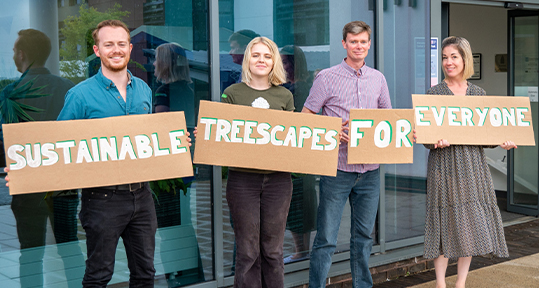
The title ‘Tree Planting Strategy’ is perhaps self-explanatory, but fails to articulate the complexities that underpin such a document. Strategic tree planting implies a plan which goes beyond a single planting season, but rather encompasses several. Such a plan will have clearly stated aims and objectives, working towards a shared vision, which can be communicated to all stakeholders involved in the management of the urban forest.
Invariably, the aims, objectives and vision underpinning a tree planting strategy will vary from locality to locality. The main purpose of a tree planting strategy is to ensure that the urban treescape is enhanced, sustainable, and resilient. It therefore needs to take account of local conditions to ensure that tree planting is focused on local priorities, aims and objectives, with a route map to success outlined.
In its simplest form, the strategy can take the form of an Opportunity Map. This is a desktop exercise, using GIS, where potential and actual plantable space is identified, highlighting the amount of plantable space in a given area. Having identified this space remotely, the land owner or tree manager is able to assess the numbers of trees it might be possible to plant.
This opportunity mapping also allows for comparisons to be made between different areas within the same locality, and for planting to be prioritised in those areas which have the greatest need. This prioritisation can also extend to other factors, such as areas of multiple deprivation, flooding, air quality and low educational attainment. By prioritising in this way, new tree planting can be targeted to the areas of greatest need, thereby maximising return on planting budgets.
Opportunity mapping also provides a useful starting point from which to direct resources to potential planting sites. These will always need to be assessed on the ground to confirm whether the space identified is suitable for tree planting.
Aside from the ‘where to plant’, a more comprehensive (full) tree planting strategy will also cover ‘what to plant’, ‘how to plant’ and ‘when to plant’. Other questions might be: How can tree diversity be increased? How can ecosystem service delivery be maximised? How can the impacts of pests and diseases be minimised? How can the effects of climate change be mitigated? A tree planting strategy can also allow for a stocking level to be calculated, based on the maximum number of trees a particular locality can hold. Planting can also be balanced to counter the natural and dynamic losses which inevitably occur in any tree population.
Finally, tree planting strategies allow for long-term forecasting. This might include a consideration of what might happen to canopy cover over the next 30, 60 or 100 years, if no tree planting takes place, with the associated future benefits of tree planting calculated and scaled over time. It is also possible to produce breakeven points to assess when tree planting will begin to deliver significant ecosystem benefits, and when the investment made in tree planting will begin to pay back both economically and socially.
We can work with you to develop either an Opportunity Map or a full Tree Planting Strategy, to suit your needs and your budget. We can discuss what you wish to achieve, and the goals that can help you to get there. Community consultation is also a key part of a tree planting strategy, and we can guide you through this process too.
Contact our team today, to see how we can help!


